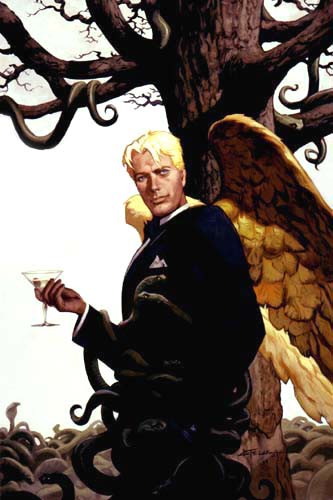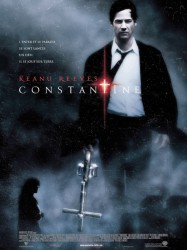Lucifer

- Infos
- Photos
- Meilleurs films
Si vous aimez ce personnage, faites-le savoir !
Lucifer Samaël Morningstar est un personnage de fiction qui apparaît principalement comme personnage secondaire dans la série de bandes dessinées Sandman et comme personnage principal d'une série dérivée. Bien que DC Comics présente historiquement diverses représentations de l'ange déchu dans la Bible et le diable du christianisme Lucifer, cette interprétation de Neil Gaiman fait ses débuts dans Sandman en 1989.Plus tard, le personnage acquiert une série dérivée à son nom, Lucifer, écrite par Mike Carey, qui décrit ses aventures notamment sur Terre et au paradis après avoir abandonné l'enfer. Lucifer apparaît également en tant que personnage secondaire dans des numéros d'Etrigan, du Spectre et d'autres bandes dessinées de l'univers DC.
En 2010, IGN désigne Lucifer comme le 68e plus grand méchant de tous les temps dans la bande dessinée.
Lucifer est apparu dans le film Constantine, interprété par Peter Stormare. Lucifer apparaît également comme le personnage principal dans une série télévisée, Lucifer, interprété par Tom Ellis.
Biographie
Sandman continuityIn the earlier related series The Sandman, written by Neil Gaiman, Lucifer abandoned his lordship over Hell. While Lucifer had previously appeared in various stereotypical guises in earlier DC books, Gaiman's version was premised on English poet and prose writer John Milton's Paradise Lost (at Gaiman's request of the artist, Lucifer looks like David Bowie at the time). In the Sandman series, Lucifer had ruled as Lord of Hell for 10,000,000,000 years after rebelling three seconds after Creation. Over that time, he had manipulated the various demons of Hell against each other, provided a place for dead mortals to be tormented, and led the war against Heaven.
However, at some point during his rule, he had become bored with his existence. He became tired of the various stereotypes and prejudices that mortals held of the Devil, such as the idea that he purchased and traded for souls, which were largely untrue, and that he forced mortals to commit evil acts. He had become tired of his reign over Hell, and felt it an unfair punishment that he should have to rule there forever simply because he once rebelled. In the Sandman story "Season of Mists", Lucifer expels all demons and damned souls from Hell before locking Hell's gates and handing over the key to Hell to Dream of the Endless, the title character of the Sandman series. Eventually, control of Hell was handed over to two angels, Duma (the angel of silence) and Remiel ("set over those who rise"), while Lucifer simply retired to Earth, initially to Perth, Western Australia and later to Los Angeles, California.
By the end of the series, however, it is revealed that Hell was not a punishment, but a gift: being the furthest possible place from God, Lucifer could theoretically be free from predestination and God's omniscience. However, this turned out to be a lie, as God continued to study both Lucifer and Michael Demiurgos during all of eternity (which partly explains how Lucifer felt cheated by his father and simply left Hell into someone else's care). Lucifer never created the physical features of Hell - Hell created itself around him.
Solo series
Lucifer was the main character in an eponymous series that ran for 75 issues and the Lucifer: Nirvana one-shot, from June 2000 to August 2006, the entire run of which was written by Mike Carey. (This series was preceded by Carey's work in 1999, The Sandman Presents: Lucifer miniseries.) To Carey, the essence of the character was:
We play safe. Most of us do, most of the time... but Lucifer doesn't know the meaning of safe, and he never bothers to look down at the tramlines. He goes wherever the hell he likes, picks his fights where he finds them and generally wins... following [his] own will and [his] own instincts to the very end of the line, no matter what the obstacles are.
In the series, Lucifer runs a piano bar (an element introduced in the Sandman story "The Kindly Ones") called "Lux" in Los Angeles, with the assistance of his female consort, Mazikeen who is a Lilim, one of the race descended from Lilith. Lucifer is portrayed as a sophisticated and charming man, in accordance with the stereotypical gentleman-devil.
The theme of the Lucifer series revolves around the free-will problem. Carey's Lucifer is a figure representing will and individual willpower, who challenges the "tyranny of predestination". While in Heaven's eyes this is blasphemy, Lucifer points out that the rebellion (and indeed all sin) and damnation as consequence were pre-planned by his Creator, God. Lucifer rejects God's rule and moral philosophy as tyrannical and unjust. The violent, aggressive, totalitarian, vengeful, and dictatorial aspects of Heaven's rule are represented mostly by the Archangel Amenadiel, who has a particular hatred of Lucifer and leads attacks of various kinds against him. The attacks include verbal criticism, marshaling the host of Heaven, as well as challenging him to individual combat - almost all of it without the slightest care for the countless innocent, unwilling and unwitting victims he is more than willing to sacrifice for his own pride. For his part, Lucifer disdains Amenadiel, treating the latter's emotional outbursts with contempt, and repeatedly defeats Amenadiel's assaults with well-orchestrated, hidden plans. Ironically, however, it is often difficult to discern when Lucifer acts as a slave to predestination and when he effectively acts according to his own free will.
Elaborate codes of conduct and schemes of entrapment based on these codes are vital elements of the DCVertigo magical universe. Lucifer appears as a master of these arts. In an encounter during the first Sandman story arc (around issue #5) a weakened Dream outsmarts Lucifer. Lucifer first swears revenge on Dream, but later comes to accept Dream's critique of his role and project as Lord of Hell. This inspires Lucifer's abdication, a vital element of the Sandman saga, and the point of departure for the Lucifer series.
For Lucifer, his word is bond. As David Easterman, a character who sees himself as a victim of Lucifer, puts it:
When the Devil wants you to do something, he doesn't lie at all. He tells you the exact, literal truth. And he lets you find your own way to Hell.
Despite his theological title as the "Lord of Lies", refusal to lie is central to the moral position of the character - he sees himself as a neutral or amoral facilitator of forces within individuals, and Lucifer actively and effectively combats what he regards as corrupting moral codes. While he avoids lying, his morality seldom extends to compassion, with Lucifer regarding the sacrifice of millions of souls as unimportant collateral damage, with there being few, if any, beings he respects and even fewer for whom he cares.
As the series opened in 2000, Lucifer's "restful" retirement was disturbed by a series of associates from his past. After various catalytic events, he endeavored to create a universe in competition with (and presumably against the wishes of) his father, Yahweh. This puts him on a collision course with several powerful mystical entities that have a vested interest in the new creation and draws the angelic host into the fray - including his brother, the archangel Michael Demiurgos, and his niece, Elaine Belloc.
The series paralleled The Sandman in several ways, with epic fantasy stories being told in arcs separated by one-shot episodes depicting a smaller, more personal tale. Unlike The Sandman, the series has had a consistent art team in Peter Gross and Ryan Kelly, with most of the odd issues illustrated by Dean Ormston. The title's 50th issue was penciled by P. Craig Russell, an homage to The Sandman #50. Structurally, the series mostly follows its own path. Numerous gods appear, with greater focus on Judeo-Christian religion (as viewed by John Milton in Paradise Lost), Japanese, and Nordic mythology than in Sandman. As for the Endless themselves, Dream, Death, Delirium, and Destiny appear, but their appearances are small and rare. Destiny, perhaps, plays the biggest role in so far as he represents predestination, which Lucifer of course finds "offensive as a concept," stating that Lucifer knows Destiny is "really just a SIDE effect of [Lucifer's] FATHER, or rather, his deterministic APPROACH to the act of creation."
Cover artists included Duncan Fegredo, Christopher Moeller and Mike Kaluta. The letters are inconsistent, with the first half of the series carrying particularly established fonts of Gaudium, Michael and God, only to drop almost all of them, save Lucifer's, towards the end with numerous changes in the letterers.
The series ended in June 2006 with issue #75 and has thus far been collected in eleven books, with a standalone story (Lucifer: Nirvana) published as a smaller graphic novel. The series' parent title, The Sandman, also ran for 75 issues.
When Lucifer ventures outside Creation, he sees something resembling the comics pages themselves. In the end of the Lucifer story arc, God and the Devil are no longer part of the universe, and a former human (Elaine Belloc) is instead presiding over it. New concepts for Heaven and Hell are created, inspired and influenced by other human or superhuman characters in the story. The new situation is described on several occasions by the fallen cherubs Gaudium and Spera. In essence, it is "growing up", i.e., the need to find one's own truth and values without being directed by parents, elders, teachers, authority figures, etc.
The New 52
The New 52 reinterpretation of Lucifer is much more influenced by traditional Judeo-Christian theology. He is depicted as a malevolent, sadistic, and cunning fallen angel who is the ruler of Hell and seeks to possess human souls. He is held with great respect and fear by the denizens of Hell, who serve and obey him like a king. Lucifer himself however is mostly bored with his existence when the group known as the Demon Knights are captured by him during the early Middle Ages, and passes the time by finding small amusements, such as watching the struggles and falls of Etrigan the Demon.
Lucifer made a more physical appearance in I...Vampire #19 after being tipped by John Constantine in destroying Cain. Lucifer immediately sentences Cain and drags him to Hell. Though a being claiming to be him has appeared in the modern age of DC to the hero Deadman, the current whereabouts and status of Lucifer remain unknown.
Ses meilleurs films
Joué par l'acteur
Filmographie de Lucifer (1 films)

Constantine (2005)
, 2h1Réalisé par Francis Lawrence
Origine Etats-Unis
Genres Drame, Thriller, Fantastique, Fantasy, Action, Horreur
Thèmes Religion, Le suicide, Le futur, Ange, Diable, Super-héros, Politique, Dystopique, Super-héros inspiré de comics, Film catastrophe
Acteurs Keanu Reeves, Rachel Weisz, Shia LaBeouf, Tilda Swinton, Pruitt Taylor Vince, Djimon Hounsou
Note70%





John Constantine est occultiste et exorciste. Il est atteint d'un cancer du poumon en phase terminale et promis à l'enfer, en raison d'une tentative de suicide dans sa jeunesse. Après avoir manqué d'échouer lors d'une mission, en chassant un démon du corps d'une enfant, il fait la rencontre d'Angela Dodson, une femme policière dont la sœur jumelle, Isabel, vient de se suicider. Elle refuse pourtant de croire à cette possibilité, persuadée qu'on l'a assassinée. Constantine et Dodson, aidés de Chas Kramer et de Papa Midnight, vont tenter d'élucider ce mystère. Mais au Mexique un mineur a découvert la Lance du destin et, sous l'influence de son pouvoir, part pour Los Angeles libérer le fils de Satan. Le démon tentera de s'incarner à travers le corps d'Angela, la mission de Constantine sera de l'en empêcher.
 Connexion
Connexion
